=This post is sponsored by the National Peanut Board.

With the latest research suggesting early peanut introduction, we’ve rounded up 8 ways on how to feed peanut butter to baby.
Turning six months was a big milestone for our sweet baby boy. He started crawling forward on his half birthday, cut two teeth, began pulling himself to standing and started solid foods. He’s still our happy go lucky baby and it’s been fun to watch him discover new things, especially as we begin our baby led weaning journey.
Brooks was teething around 5 to 5 ½ months, so I started out offering him frozen breast milk pops in our favorite silicone feeders. This was our first step into solids for both of my boys because it gets them used to putting “food” they already love in their mouth. Not to mention it provides comfort for the teething pain too. Win-win for both of us!

At the 6 ½-month mark, here’s a line-up of foods he has “tasted”, in developmentally appropriate forms of course.
- Avocado
- Banana
- Mango
- Butternut squash
- Carrots
- Apples
- Watermelon
- Pears
- Spinach
- Prunes
- Blueberries
- Peanut butter
- Strawberries
- Peaches
- Cottage cheese
- Beef
- Asparagus
- Sweet potato
- Chia seeds
- Full fat plain yogurt
- Kale
- Lentils
- Brown Rice
- Tomatoes
When can babies have peanut butter?
We don’t have any food allergies in our family but as a new mom it can be nerve-wracking to serve your tiny baby foods from the top allergen list, which was once on the no-no list. However, for babies at high risk for peanut allergy, early introduction is even more important because it can reduce risk of developing an allergy to peanuts by 80%.
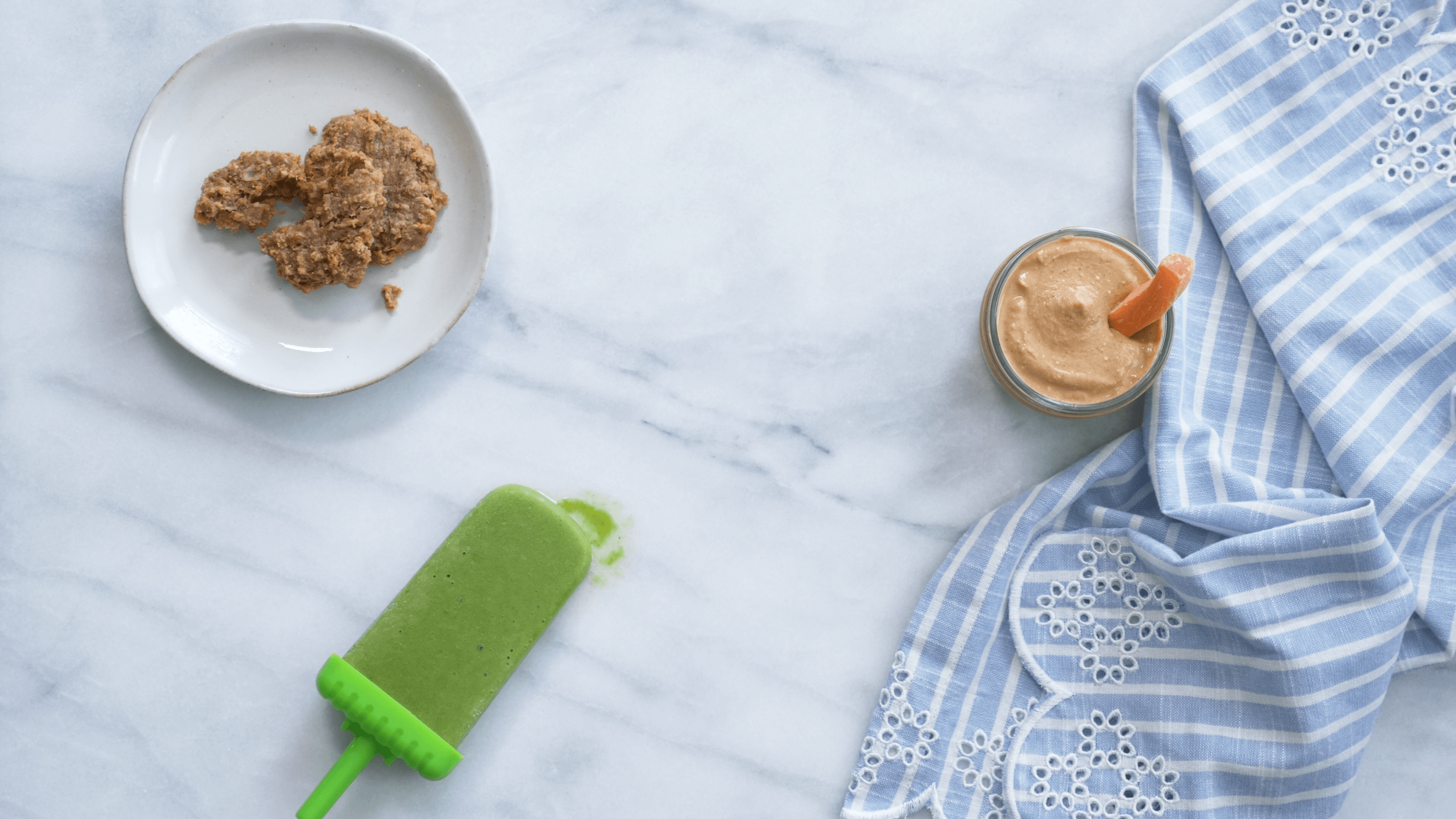
How to keep your baby safe when feeding peanut butter to baby?
According to the guidelines, if your child has severe eczema or already has egg allergy, it’s important to discuss introducing peanut products with your doctor before baby’s first bite.
Not only will this give you peace of mind, but also if your baby is at high risk for food allergies your doctor may recommend allergy testing first and early introduction under medical supervision. If your baby isn’t in this category, it’s not necessary to discuss with your pediatrician first, but you can always do that if you prefer.
When giving peanut-containing foods to your baby, it’s important to remember whole peanuts should never be given as they are a choking hazard for babies, and lumps of peanut butter can be dangerous because it’s thick and sticky, so be sure that peanut butter is always properly thinned.
To read more about home feeding safety, check out these guidelines from National Institute of Allergy and Infectious Disease and preventpeanutallergies.org is a great resource too!
How to give baby peanut butter?
I use a modified baby led weaning approach to feeding, and so far, Brooks has ‘teethed” on foods that he can’t currently break with his gums, like large carrot sticks, big pieces of steak, and very firm apple sticks.
He’s eaten purees and smashes like avocado and sweet potatoes from a self-feeding spoon or on his tray table. He also loves squeeze pouches! And his favorite method of getting food into his mouth is via frozen foods (using the silicone feeder), so this is how we introduced peanut butter— a blended smoothie, frozen in an ice cube tray and served in the feeder. Be sure to check out the video for his reaction to peanut butter.
Again, feeding babies is a highly individual process. What works for us may or may not work for you or someone else you love, so it’s important to follow your baby’s developmental and readiness cues and feed peanut butter to baby in appropriate forms, and in a way that makes you feel comfortable.
Looking for how to feed peanut butter to baby?
Here are eight of our favorite ways to introduce peanut-containing foods to an infant.
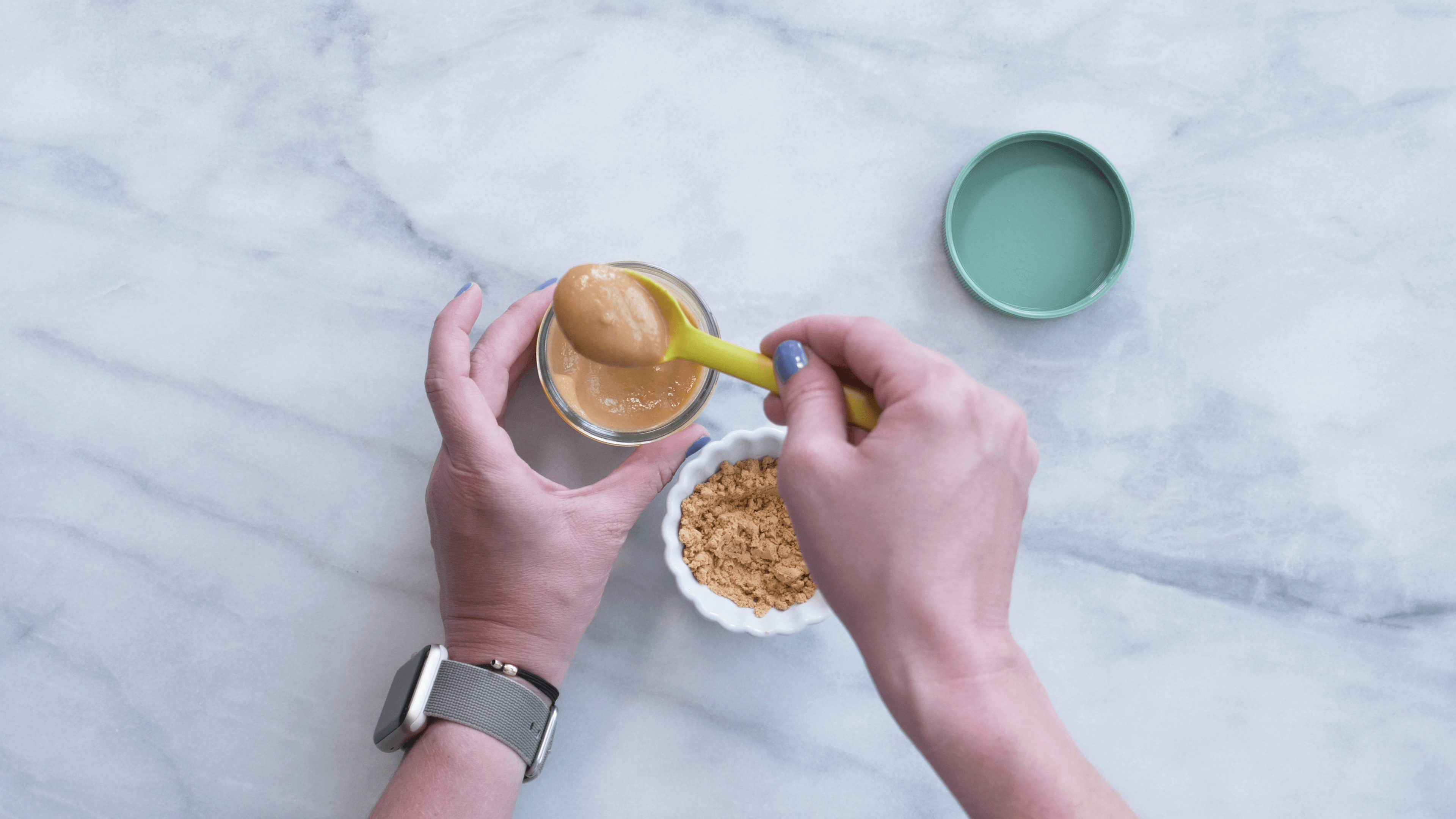
-
Puree. The easier the better at our house. Oh, you too? We’re on the same page mama! Mix your babe’s favorite fruit or veggie puree with peanut butter powder. If you’re introducing peanut butter to the early eater, purees make a seamless and safe method. If you’re doing baby led weaning approach or have an independent eater, dip your baby feeding spoon into the puree and offer it to baby.
Prep it: Mix ¼ cup pureed pears (or favorite food) with 2-3 teaspoons powdered peanut butter.
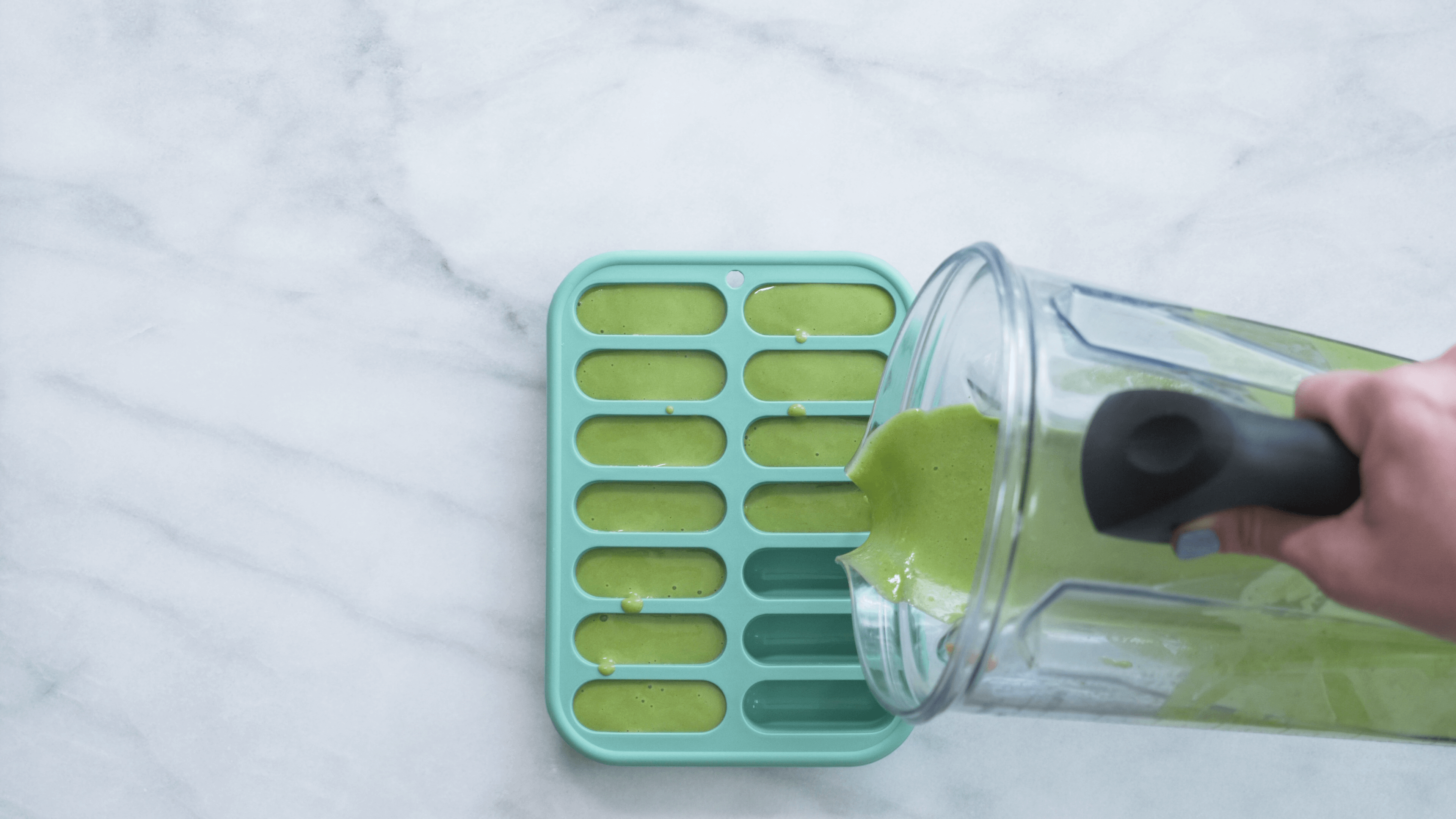
-
Frozen. A quick blend of spinach, peanut butter, mango, banana, and either water or expressed milk; served to baby through a straw or frozen into popsicle molds or ice cube trays and popped into silicone or mesh feeders. Great recipe for even your earliest eaters! We offered these pops in a silicone feeder to my 6 month old baby as his first peanut butter food.
Prep it: Blend 1 cup spinach, 1 tablespoon peanut butter, ½ cup frozen mango, 1 banana and ½ cup expressed milk or water. Pour into popsicle molds, ice cube trays or serve with a straw.
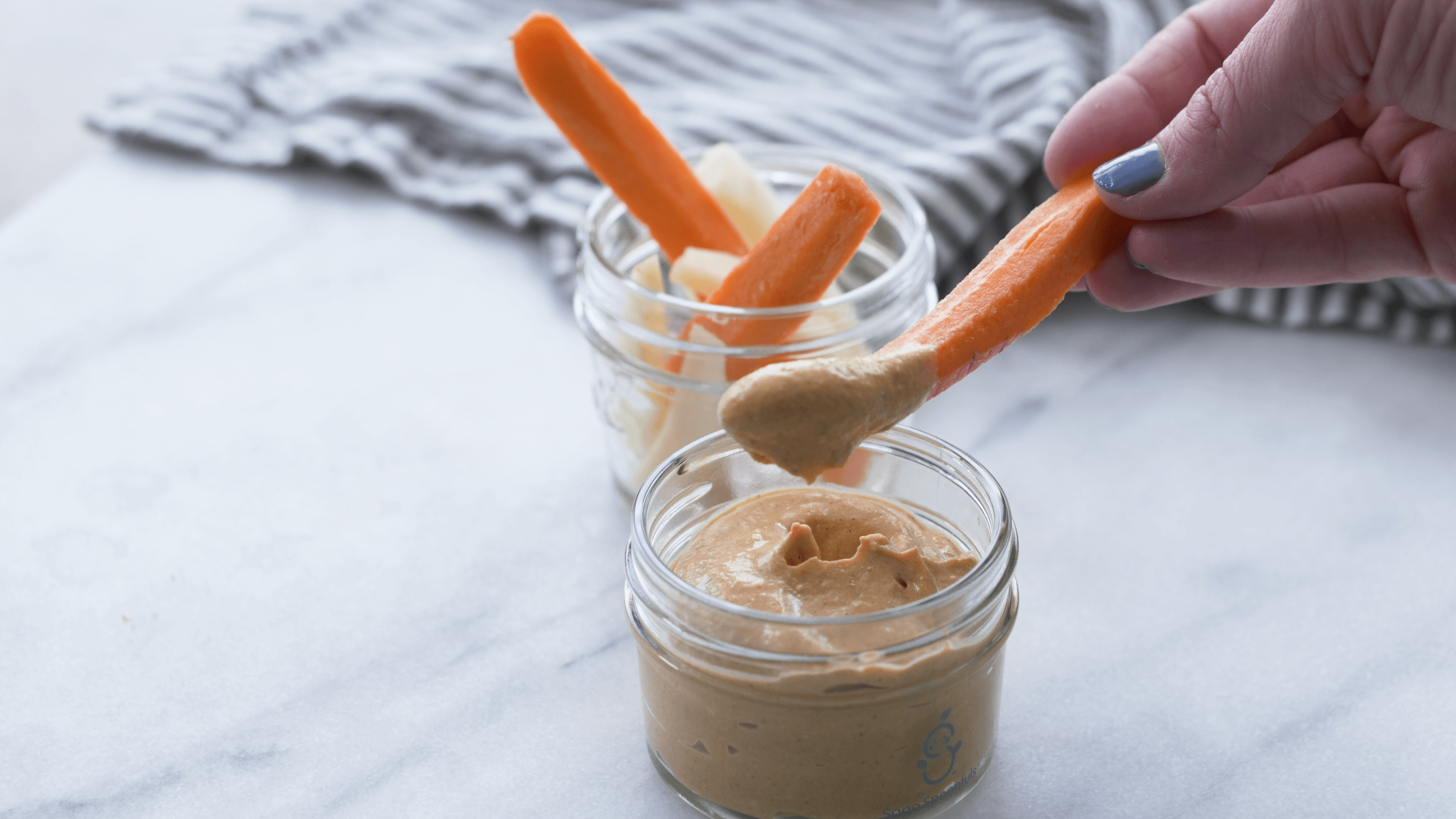
-
Dip. Pumpkin PB Yogurt Dip great for baby led weaning! We pair this dip with extra firm apple slices and carrot sticks that the tiniest eaters can’t mash with their gums. The produce in this case is more of a teether and a vessel to enjoy their first tastes of peanut butter while allowing baby to explore with self-feeding. This dip can even be used with teething biscuits.
Prep it: In a bowl, stir together ½ cup whole milk yogurt, ¼ cup canned pumpkin puree, 3 tablespoons peanut butter powder, and a pinch of cinnamon.
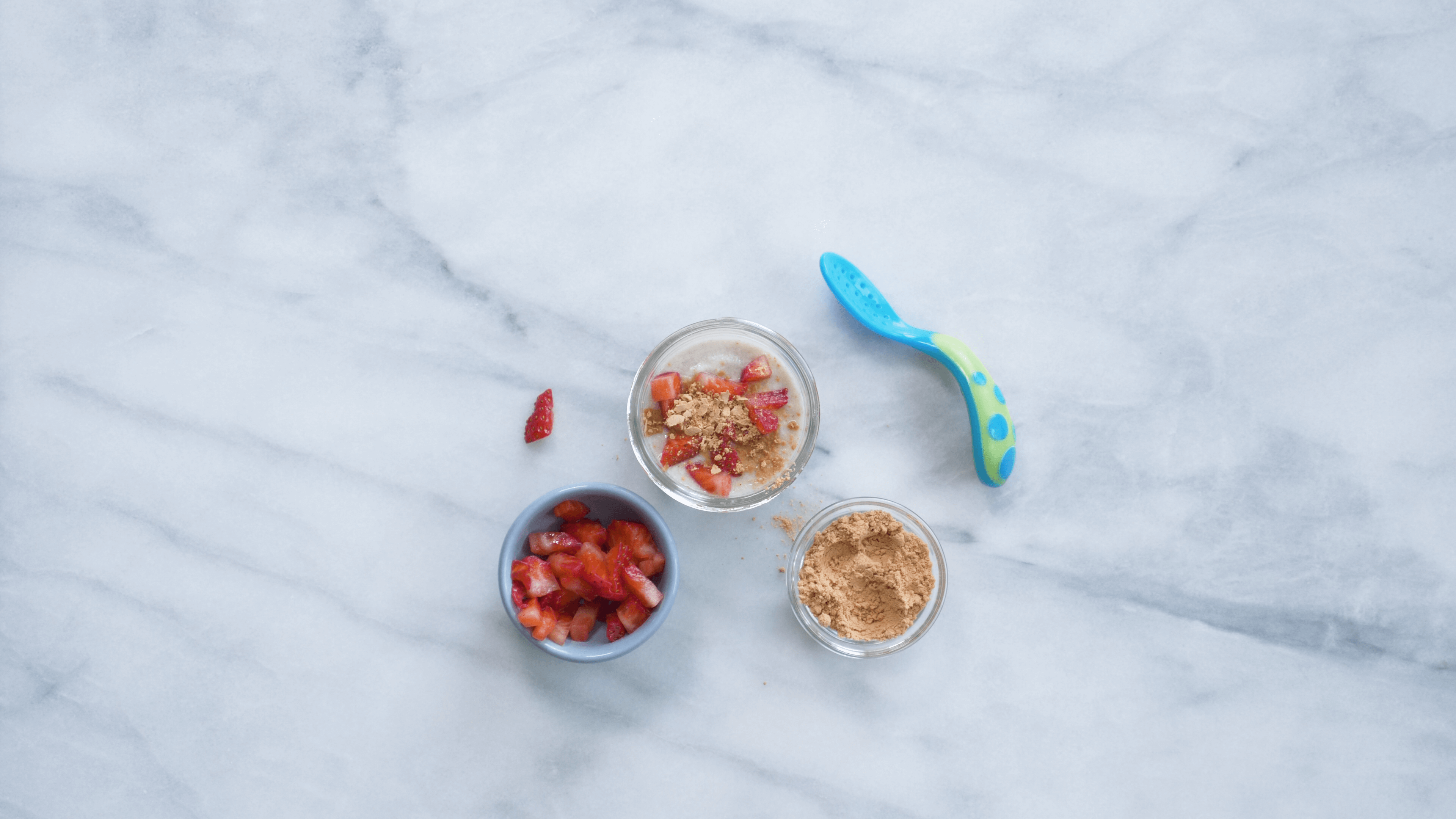
-
Sprinkle. Peanut butter powder is one of our favorite early introduction peanut products because just a little sprinkle “melts” into the foods your baby is already enjoying… like oatmeal!
Prep it: Prepare your favorite baby oatmeal or cereal with strawberries (diced, mashed, or pureed), and sprinkle with a little PB powder. Give it a stir and dunk with a spoon to serve to your baby.
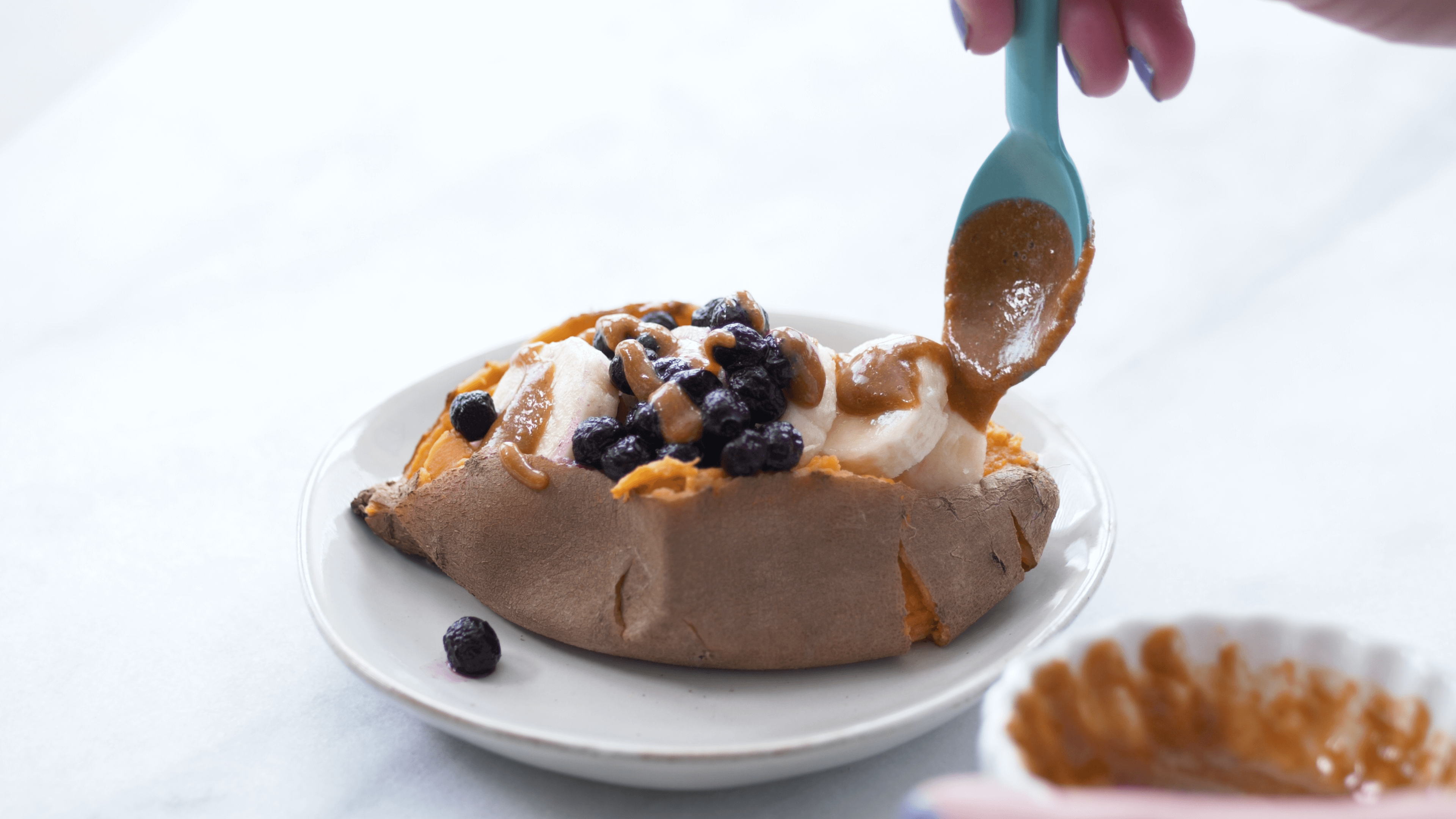
-
Drizzle. Stuffed Sweet Potatoes with PB drizzle is a mama and baby favorite at our house. Sweet potatoes stuffed with banana, wild blueberries, and drizzled with a peanut butter + maple syrup and hot water mixture.
Prep it: Cook sweet potato in microwave for 5 minutes or until very soft. Split open with a knife and stuff with banana slices (or smash), wild blueberries (for older babies that can have more texture or muddled in with banana to mash into a puree). In a small bowl, mix together 2 teaspoons of peanut butter with a 2 teaspoons of hot water and a teaspoon of maple syrup. Drizzle thinned peanut butter over sweet potato.
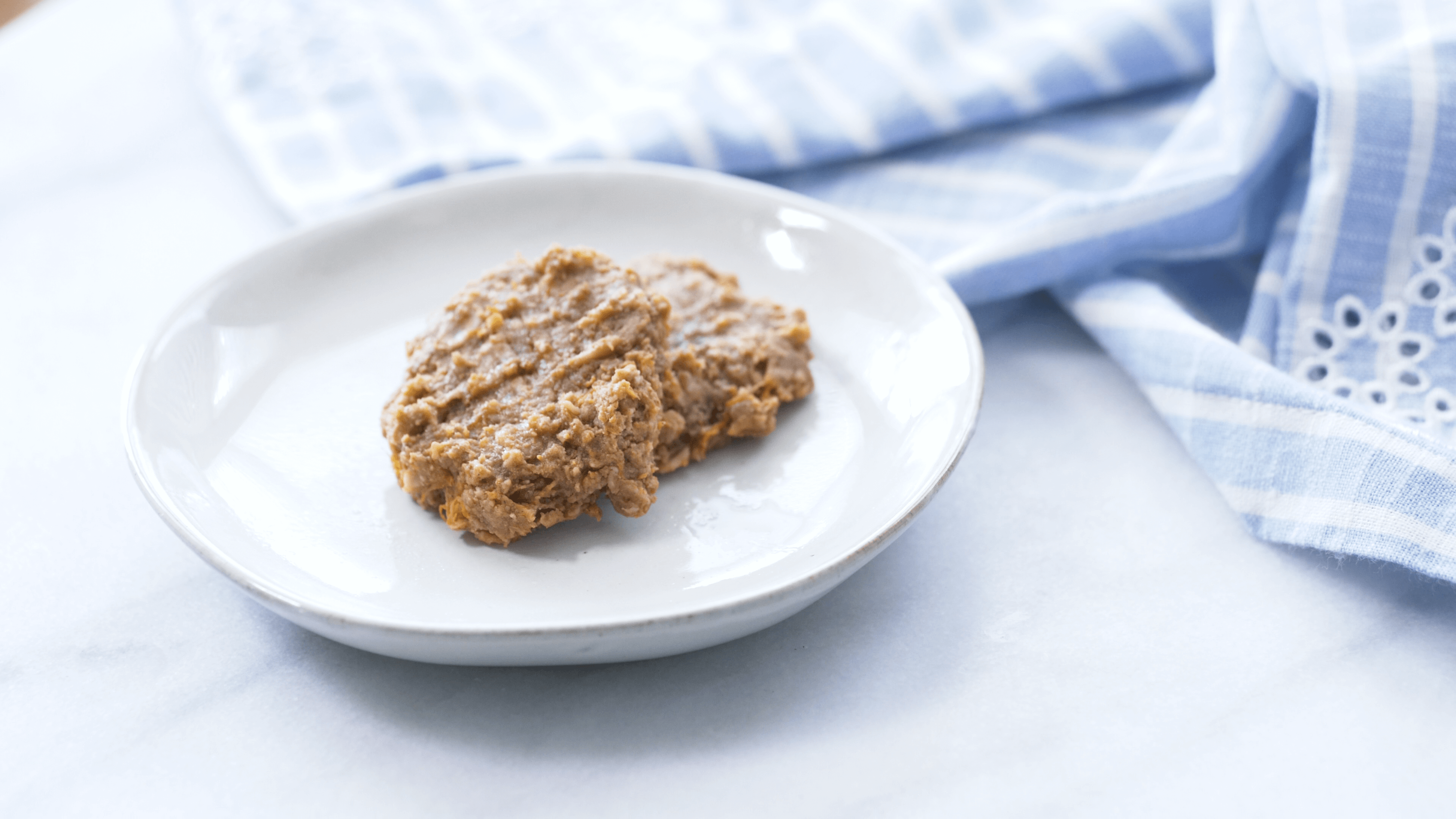
-
Bake. A simple soft breakfast cookie recipe for baby made with only 4 ingredients- butternut squash, oats, peanut butter and cinnamon. We love these at our house!
Prep it: Preheat oven to 375 degrees F; line baking sheet with parchment paper. In a mixing bowl, stir together ½ cup raw oats, ½ cup pureed butternut squash, ¼ cup peanut butter, and ½ teaspoon cinnamon. Roll into 12 even cookies and smash with a fork. Bake for 12 minutes; allow to cool before serving to baby.

-
Spread. Fluffy PB spread on top of baby pancakes FTW. As a matter of fact, whipping hot water with creamy peanut butter makes a tasty pancake topping that’s safe for baby.
Prep it: Make your favorite pancake recipe! In a small bowl whisk together 2 teaspoons peanut butter and 2 teaspoons hot water. Add water 1 teaspoon at a time until you reach a light and fluffy consistency. Keep in mind, depending on the brand some peanut butters need more water to reach desired texture.
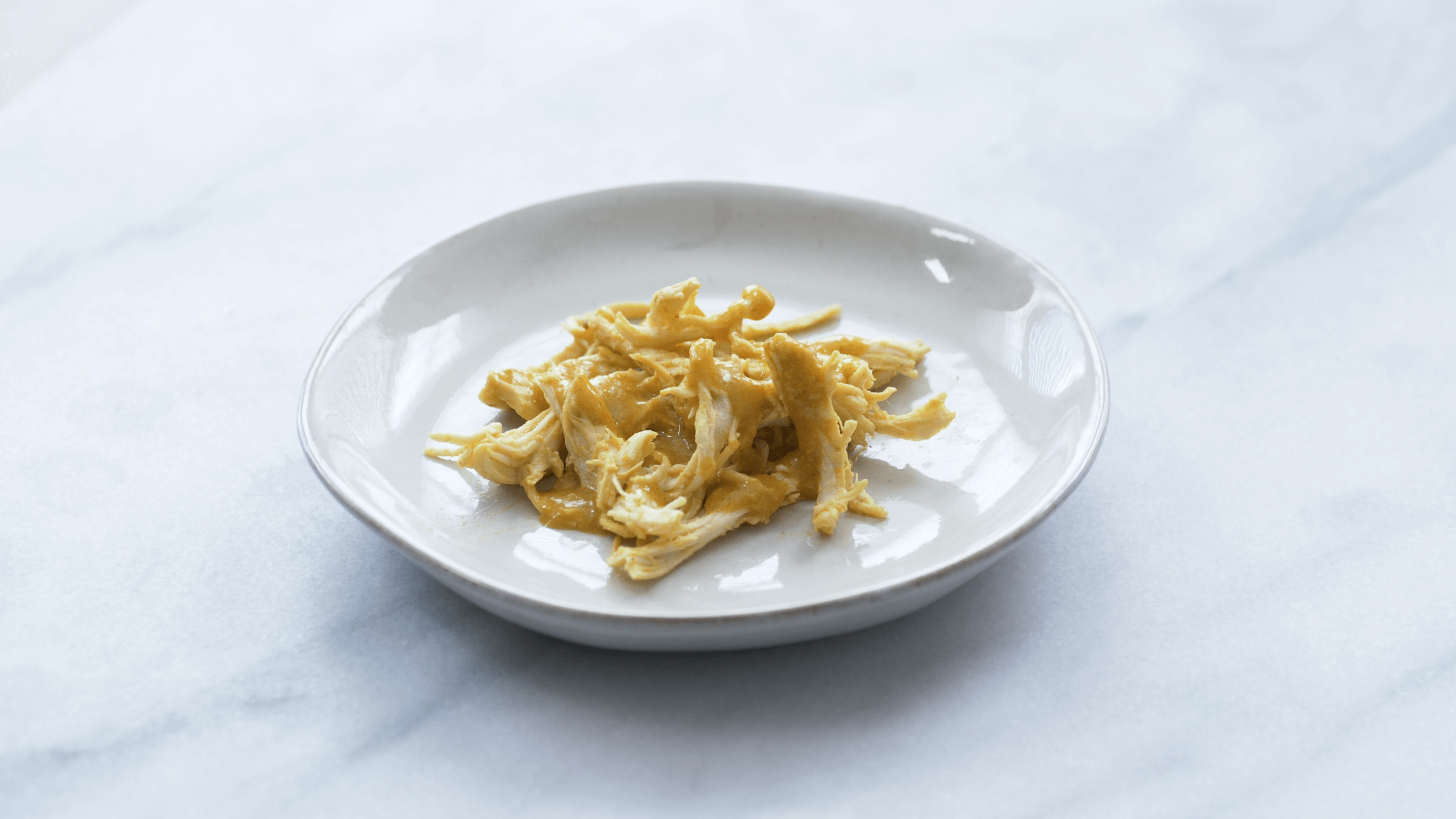
-
Sauce. Soft pulled chicken is a more advanced food for older infants, but if your babe is already enjoying poultry, try adding a little peanut butter twist! Coconut milk, turmeric, chicken and peanut butter– 4 simple ingredients create a dish your whole family is sure to love.
Prep it: In a slow cooker or Instant Pot, add one can coconut milk, 1 tablespoon ground turmeric, 1 pound chicken, and ¼ cup peanut butter; give it a stir. Close lid and cook on low for 6 hours in slow cooker and on poultry setting (12 minutes on high pressure) in the Instant Pot. When chicken is fully cooked, remove from pot and shred into appropriate size pieces for your baby. Stir remaining sauce in the pot to create a creamy texture; pour sauce on pulled chicken before serving.
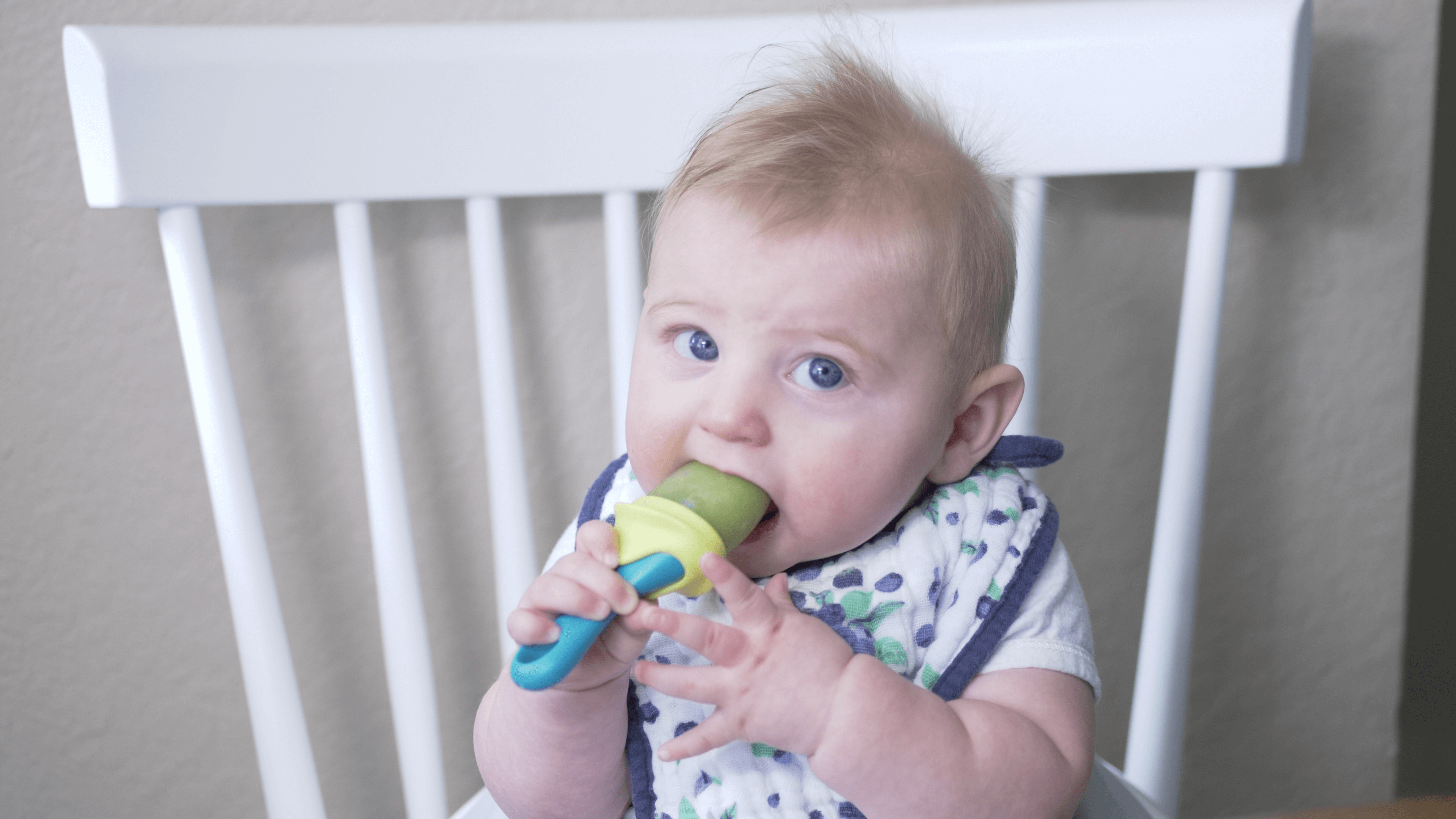
I’d love to know, how did you first introduce peanut butter to your baby?
Hope these how to feed peanut butter to baby tips help with your early introduction adventures!
Looking for more posts on babies and motherhood?
-
20 Pre Workout Snacks to Fuel Busy Mom’s on the Go
-
Bump date 33 Weeks: Best and Worst Things about Pregnancy (so far)
-
Birth Story: I had a baby on an elevator
Hi I’m Kristina LaRue, RD (registered dietitian nutritionist), Peloton addict and mama to two active and hungry boys. On Love & Zest, you’ll find healthy-ish recipes that fuel the whole family. I’m all about veggie-filled breakfast, meal prep recipes, healthier sweets, and easy weeknight dinners made in the Instant Pot or sheet pan.
Did you make one of my recipes?? Leave a review in the comments and tag @loveandzest #loveandzest on Instagram!
If you’re a modern mama– I’d love for you to join my Facebook group A Modern Motherhood Collective!
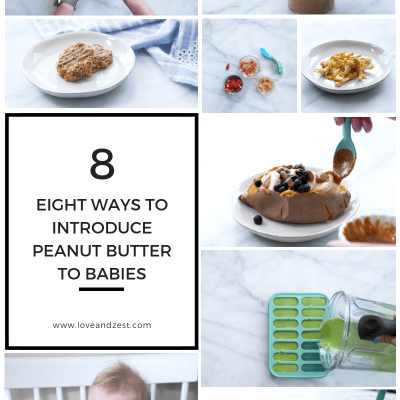
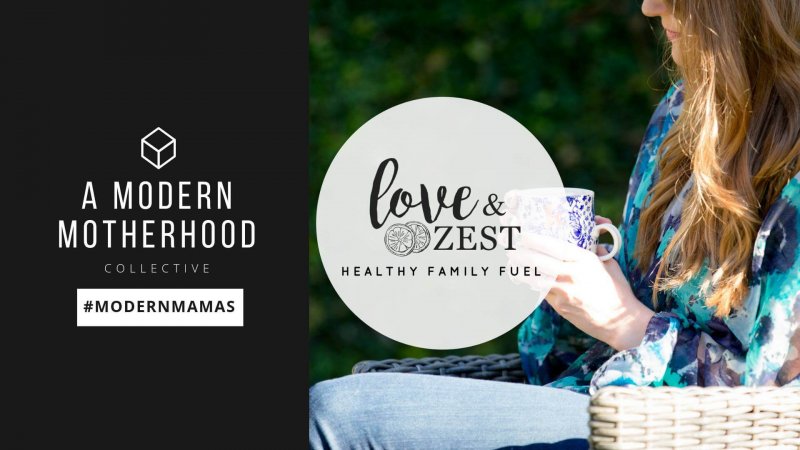


Such great information!! I am from the generation where we fed our babies everything. No one worried about peanut allergies back then. But with my grandchildren, we are much more careful and will follow your information!
My younger sister is expecting and this would surely be of great help to her, Thanks Kristina!
Grat post! Sharing it with my baby mama/soon to be baby mama friends!
What an interesting and educational post, I really enjoyed reading it! Who knew peanut butter was such an interesting topic, but i enjoyed reading the post. Thanks
My daughter loves peanut butter and we usually have it in a smoothie every day
What a great article! Although I no longer have babies, I know many of my friends will appreciate this article greatly, thank you! Quite informative and what great options you offer to first introduce peanut butter. I will forward this post to a few friends.